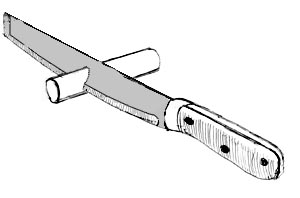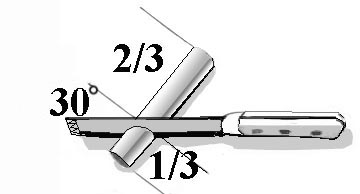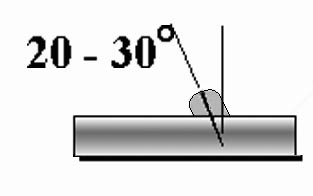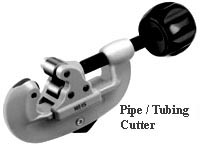Displaying A Knife Collection, Part II -on the Flat:
Lately a lot of people have asked me how to display knives. I've also built lot a drawer cases and coffee tables for knife collectors. (Check out some beautiful collections in my Customer's Scrapbook.)
Knives are obviously a popular collectable and are a worthy collectable too --worthy of careful and SAFE display. So I've been kicking it around. I've even reread my first article on the subject - Displaying a Knife Collection. Some good advice there, but it has more to do with displaying knives on the wall then it does with displaying them in a coffee table or protecting them in drawers -on the flat so to speak. I've come up with a great idea, not that I'm the first one to come up with this idea, but I have lots of How-To advice.
What'cher gon'na do is, is to cut a notch in a suitable rod of some sort at a suitable angle, and put your knife in it. Looks like this….

The trick is to find a suitable rod and cut a suitable angle of a suitable width and depth. If you have read some of my other articles in HOW-TO for Collectors, you know I'm a big fan of displaying collectables in a suitable background. Often this means on an appropriate fabric -silk for a delicate tea-cup collection, leather for cowboy-stuff, etc, but this also means appropriate "furniture* " Taken from the above referenced article on displaying knives, I suggested, for example, wrought-iron for a old broadsword, polished chrome or even clear acrylic for a modern ceramic folder. Any number of interesting materials can be easily found in your local home-center store, or take a brief spin on-line. I will take up some other possibilities shortly, but for the time being, lets consider a simple wooden dowel, probably maple, from the home improvement store.
A piece of maple dowel is cheap, cuts easily with tools you probably already have on hand, can be finished in a number of beautiful ways, and finally, it's not going to damage the blade of a valuable knife. It all depends on your collection, but if you don't know quite where to start, do this, (and modify it as you go along if you like):
- Use dowel the same size as the largest diametric dimension of your knife -or one size smaller.
- Cut it to about half the length of the knife -unfolded if it's a pocket knife.
- Make your notch one third of the way back from the prettiest end of the dowel.
- Cut your notch at 30° from perpendicular to the length of your dowel and at 20° to 30° from vertical.
Looks like this:


- Finally, don't cut more than two thirds to three quarters of the way through the dowel.
As to tools, you can use the kitchen table and the rusty old handsaw that got left out in the back-yard all winter. Certainly a nice sharp saw is easier to use as is a work bench with a vise, but I'd not get all carried away with power tools. Control -cutting no more then you need to- is the key here. If you have all manner of power-tools -band saws and such, you probably don't need my advice on how to use them. The only tricky bit is the width of the blade & the width of the subsequent cut, (the "kerf") with respect to the thickness of the knife blade. It's possible the blade will be thicker than your cut is wide. This might not make any difference --it just means that the knife will be wedged in and sit up a little higher. This might actually be a good thing. The alternative of course is to make the notch a little wider. You can do this with a careful second saw-cut, or some sand-paper, or… I don't know… a little work with a knife?!?
Here are some other possible materials for stands.
Copper Pipe:
1/2" or 3/4" ID from the home-center store. Easy to cut to length with a tube / pipe cutter and soft enough to cut the notch with a hacksaw or a fine tooth wood-saw for that mater. Touch it up with a flat and round file. A little 000 or 0000 steel wool will make it absolutely gleam and some paste wax will keep it gleaming for years. Otherwise it will tarnish -not to say that for some knife collections -a little verdigris might not be just the ticket. Watch for fingerprints which ever way you go.

Clear Acrylic.
Solid rod or tubing. This will be a little harder to find, but not much. Come in lots of sizes and is easy to cut. Looks pretty dramatic, but the cuts you make are a bear to polish-up to the point the surfaces are clear again. It can be done, but takes time, special material & tools, and some skill. Not worth it to my way of thinking. Sit yourself down in front of the TV with some assorted grit sandpaper and get'er done. Finish with some fine grit emery cloth and go for a frosted-glass look -this is pretty elegant in and of itself.
Tree Branches:
A bit of nature might be just right for certain knife collections. A bit of character and maybe even some bark on your knife display stand. If such things are easy for you, you might consider sanding down the bottom so it sits flat in your display. This makes for a little more professionalism without taking away from the rustic. But you must -you absolutely MUST make sure the branch is dry. Fail to do so, and you will have made the perfect device for rusting little semi-circles on your collectable knife. The big slabs of the fancy hardwood I use to make custom furniture take literally years to dry & cure. If you are using branches you have pruned from the old apple tree in the back yard, I'd cut them up into manageable lengths, and give them a few summer months in the attic. You could try the oven set to low overnight if you are extra impatient, but this is apt to split & crack the branches. But here again, for some collections, this might be just the ticket.
Permit me some final thoughts:
1. Don't neglect a label. Is your collection a collection or is it just a pile of funky old knives? A simple label from your computer's printer is easy and make any collection (at least look like…) a serious collection.
2. If you have doubts as to how your stand is going to get along with the knife blade, invest in some cotton -not polyester- fleece or felt. This addresses the issue of rusting your blade, and protects the knife if you are using a stand made from something like steel or some kind of rock, marble, or something abrasive. Check out my article on Fabric for the Collector
3. Give a little thought to a lock. Any collectable is apt to tempt the not-quite-honest-person, and a knife has the added issue of being dangerous in the wrong hands. Check out my article on Security for Collections